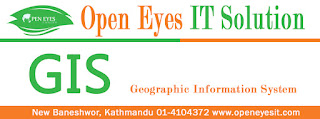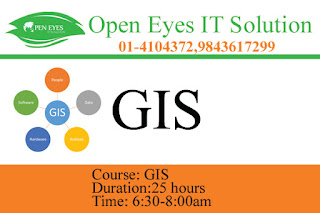Open Eyes IT Solution is going to start new session on
GIS Training in Kathmandu Nepal. Here you will get chance to learn GIS System from basic to advance in a friendly environment. Hurry uo seat are limited Enroll now. Further more details call us 977-1-4104372, 977-9843617299.
Geographic Information Systems (GIS) are software and hardware systems that enable the creation, management, analysis, and display of geographical data. These facilities combines both digital maps and textual databases. Any profession and business that is spatial related such as architecture, engineering, urban planning, real estate, marketing, transport, environmental management, and surveying, can benefit from using GIS.
The programmes are intended for full-time working practitioners in spatial-related disciplines. The programmes serve as an advancement option to enable practitioners in Kathmandu to enhance their GIS knowledge and use GIS effectively in their work. They also extend an excellent opportunity for people of all professions to constantly keep themselves abreast of the latest developments and to gain immediate insight to the utility of the techniques. Courses are offered on weekday evenings or on weekends to cater to the working class.
Understanding how and when to apply ArcGIS tools and functions is the key to creating an efficient GIS workflow. Building on the skills and knowledge taught in ArcGIS Desktop II: Tools and Functionality, this course shows how to apply ArcGIS tools in a workflow context with a focus on working with data stored in a geodatabase and performing geoprocessing and analysis. In the course exercises, you organize and edit data stored in a geodatabase, prepare data for analysis, create and edit geoprocessing models using ModelBuilder, and work through a challenging analysis project.
Topics Covered
- Getting data into the geodatabase: Advantages of migrating data to the geodatabase; File and personal geodatabases; Loading and importing data; Data sources available for conversion; ArcToolbox conversion tools; Importing and exporting data in ArcCatalog; Importing and exporting data using XML; Copying and pasting data between geodatabases; Batch and single conversions; Loading data into existing feature classes using the Simple Data Loader; Displaying x,y coordinate data from a table; Accessing tabular data using an OLE DB connection; Adding data from a GIS server; Working with map projections and datums.
- Geodatabase behavior: What is behavior?; Advantages of using behaviors; Default values; Subtypes; Domains; Geodatabase topology.
- Editing GIS data: Creating new data (digitizing, copying and pasting features, Editor menu commands); Constructing an edit sketch using constraints (direction, length, parallel); Creating adjacent polygons using the Auto-Complete Polygon task; Modifying existing features; Reshaping existing features and boundaries; Exploding multipart features; Editing using domains, subtypes, and topology.
- Alligning spatial data: Common data alignment problems; Georeferencing CAD data; Matching layer boundaries; Transformation; Rubber sheeting; RMS error.
- Managing geoprocessing tools and settings: Types of toolboxes and how they are stored; Types of tools (system tools, models, scripts); Locating tools in ArcToolbox; Executing tools; Tool parameters; Parameter error detection; Environment settings; Tool layers; Geoprocessing results.
- Analyzing GIS data: Review of common analysis tools (Buffer, Clip, Intersect, Select, Union); Working with feature proximity tools (Near, Spatial Join, Multiple Ring Buffer, Create Thiessen Polygons); Analyzing tabular data; Creating a raster subset; Analysis options outside of core ArcGIS Desktop; Typical analysis workflow.
- Using ModelBuilder for analysis: Working with ModelBuilder; Creating and designing models; Model elements (tools and variables); Setting general model properties; Setting model parameters; Environment settings; Intermediate data; Running and troubleshooting a model; Creating model documentation.





No comments:
Post a Comment